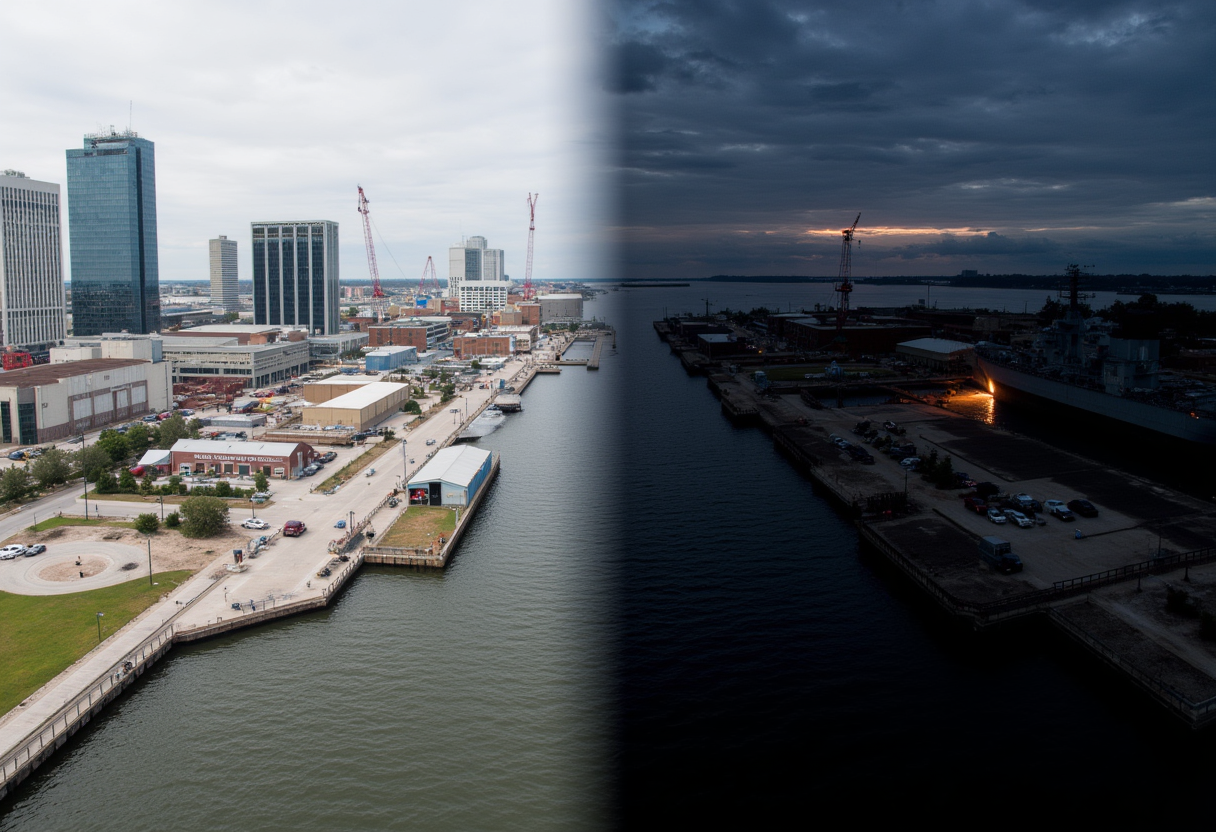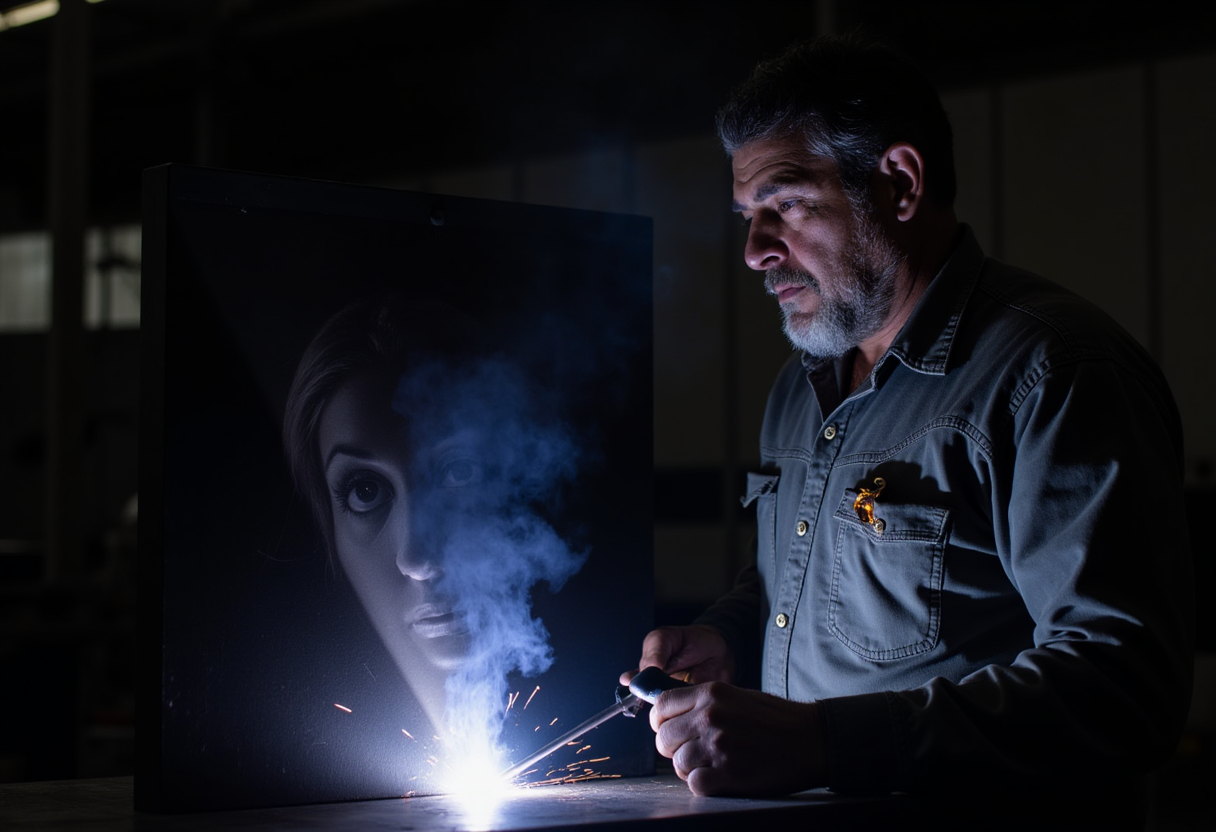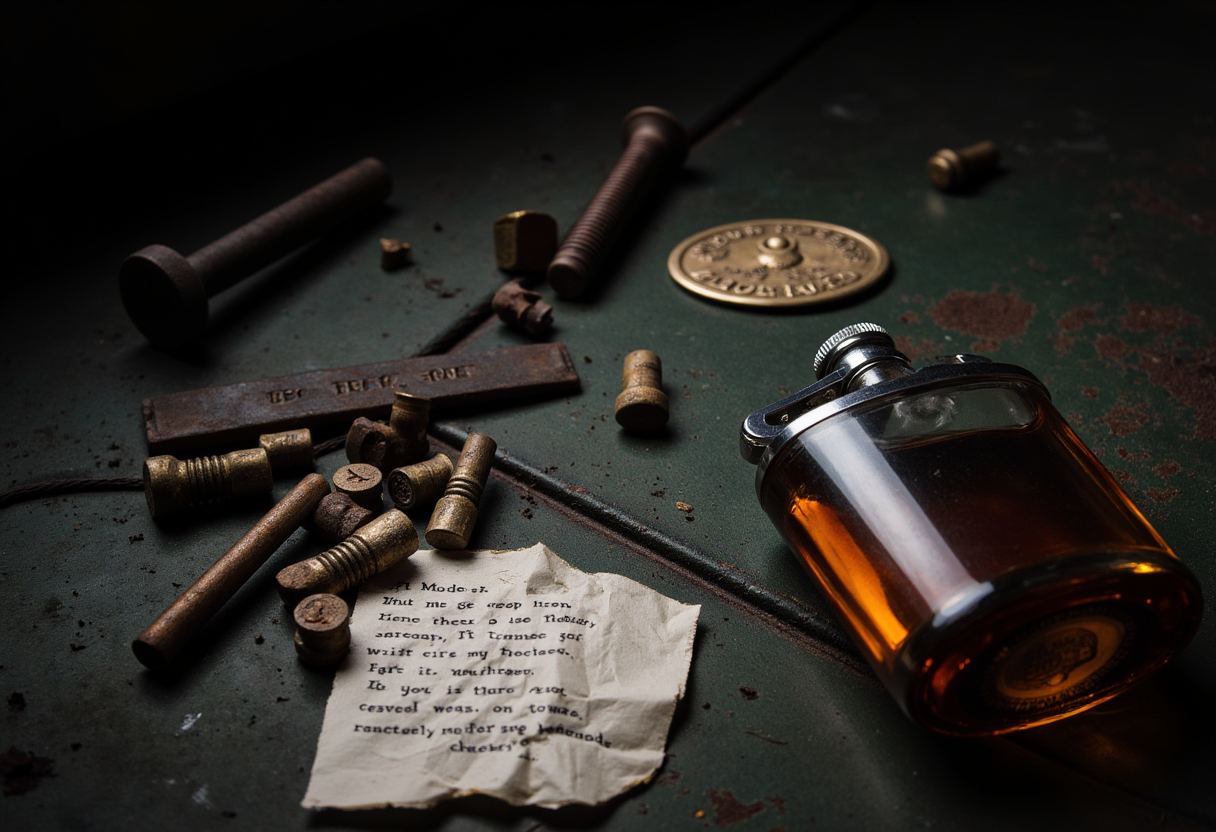The Jacksonville Shipyard Sirens
A panoramic shot illustrating the stark contrast between day and night at Jacksonville's Pier 1.
They say the welders at Pier 1 don’t work alone.
By day, Jacksonville’s waterfront is a symphony of progress—glass towers rising, cranes swinging, and developers tossing around phrases like “Silicon Beach” and “urban renaissance.” The city’s riverfront redevelopment promises parks, mixed-use towers, and new business centers that aim to remake downtown in a few short years.
But when the sun dips behind the Hyatt and the St. Johns River turns to ink, the old shipyard keeps its own clock. The air along the St. Johns tastes of salt, oil, and decades of industry; you can still hear the echo of hammers where condos now cast long shadows.
It remembers the clang of rivets and the roar of liberty ships being born along the river — the work that made this river city a crucial part of the war effort and helped shape Jacksonville’s history. It remembers the women—Rosies in coveralls—who welded through the war while their brothers fought across oceans. And it remembers the ones who never came home.
The USS Orleck sits moored at the edge of this memory, a Gearing-class destroyer turned museum, her gray hull streaked with rust and reverence.
She served in World War II, Korea, and Vietnam; crew records and museum sources list her long deployments and earned honors. The Orleck fired thousands of rounds in combat, weathered torpedoes and storms, and carries scars that read like a timeline of 20th-century conflict—earning nicknames and myths, including the moniker some veterans use: The Gray Ghost of the Vietnam Coast.
But lately, the welders say she’s not the only ghost around.
The First Flame
It began as murmurs — a whispering carried through the hollow shells of half-built yachts and the ribs of decommissioned destroyers that line the St. Johns River.
Then came the sparks: not the predictable orange flare of a torch but an electric blue that held too long, burned too clean, and felt like something listening back.
“I saw a face in the fire,” one welder told a coworker after a late shift; another, working a midnight seam, said his arc sputtered and the steel itself seemed to bend into the outline of a woman’s hand.
These are the kinds of stories the yards trade after hours — anonymous, repeated, and oddly consistent across teams who’ve worked the riverfront for years.
They call them sirens — not the sea-song that lures sailors, but sprites born of slag and memory: flashes of heat and grief, shaped by rusted catwalks, old blueprints, and the voices of women who welded during wartime.
Around the waterfront, over beers and gumbo, the folklore moves like current through Jacksonville’s neighborhoods and into the urban core.
(The Siren's Hum - Luis Romero's Experience): A dramatic shot focusing on Luis Romero's intense experience. He is a rugged, experienced welder, dropping his torch in shock.
They rise from weld lines and vents, from the places the new development renderings don’t show. They don’t scream.
They hum.
By the time the sun lifts again, the stories thread toward one constant anchor on the downtown riverfront: the USS Orleck — a ship whose history and presence make the boundary between past and present feel very thin.
The Ghost in the Hull
The Orleck is no stranger to ghosts. She’s a floating monument to American naval grit, docked now at 610 East Bay Street in downtown Jacksonville, where the riverfront’s redevelopment edges up against a history no glass tower can erase.
Her decks have seen war, peace, and everything in between. The ship—built in 1945 and named for Lieutenant Joseph Orleck, who died during the Battle of Salerno—has a long service record across World War II, Korea, and Vietnam.
Veteran accounts, museum materials, and ship logs document her deployments and honors; over the years, she has accumulated scars that read like chapters of 20th‑century conflict.
In Korea, the Orleck earned multiple battle stars; in Vietnam, she joined the ranks of ships credited with disrupting enemy supply lines—stories that gave rise to the colloquial “Train Busters” reputation among sailors.
These battlefield tales, passed down through crews and veterans’ groups, help explain why some call her the Gray Ghost of the Vietnam Coast.
Now she rests in the heart of downtown Jacksonville, a piece of living history floating between condo construction and cocktail lounges.
The juxtaposition is striking: preservationists, tourists, and developers all converge along the St. Johns River, drawn to a place where the city’s past and future literally sit side by side.
Visitors to the USS Orleck Naval Museum and volunteers report odd experiences—cold spots in the Combat Information Center, equipment that behaves inexplicably, or the sensation that someone else is nearby when the tour guide isn’t speaking.
A volunteer who asked to remain unnamed described a hiccuping audio playback and a sudden chill while a holographic narration ran in the CIC during a weekend program.
One child on a school trip later told a parent he’d seen a woman in a welding mask standing beside the 5‑inch gun mount; staff who reviewed the tour footage found no extra person on camera. Museum staff tend to explain these moments as imagination, sensory tricks, or the natural creaks of an old ship. Longtime welders and some veterans, however, treat them differently.
On quiet mornings, workers leave small tokens in seams and under plates—rusted bolts, old liberty ship tokens, handwritten prayers tucked into bulkhead cracks.
A welder reported leaving a flask of Four Roses on the bow one night; when he returned, it was empty. These offerings read less like superstition than like a language the riverfront learned long ago: a pragmatic respect for the lives and labor layered into the steel.
sepia-toned or historically styled image showing women in welding masks and coveralls, "Rosie Riveters," actively working in a bustling World War II shipyard.
The Orleck’s presence ties directly into Jacksonville’s broader shipbuilding past—the yards and shops that once lined the St. Johns—and helps explain why memories, and the stories they spawn, persist even as the waterfront changes.
A City Built on Steel and Salt
Jacksonville’s shipbuilding legacy runs deep along the St. Johns River. During World War II, shipyards such as Merrill-Stevens and companies like the Gibbs Gas Engine works expanded production to meet wartime demand, turning the riverfront into a hive of industry that stretched for miles.
Dozens of vessels—many Liberty-class ships and other support craft—were assembled and launched with astonishing speed.
Local records and wartime employment rolls show thousands of Jacksonville residents on those yards; among them were women who stepped into trades traditionally held by men, the “Rosies” who kept supply lines moving while brothers and fathers served overseas.
When the war ended, much of that industrial boom tapered off. Contracts dried up, cranes sat idle, and the constant clang of hammers on hulls grew faint.
The riverfront’s working waterfront began a slow transformation: some yards shuttered, others repurposed, and new visions for downtown development—parks, mixed-use centers, and waterfront shopping—started to reshape the area.
But the ghosts stayed. The memories of labor, sacrifice, and the people who built Jacksonville’s maritime economy are woven into the steel and salt of the shoreline, and they surface in stories, tokens, and the odd unexplained event that longshore workers and residents still talk about today.
A close-up, still-life shot of the offerings left for the ghosts on the USS Orleck.
The Fire Wouldn’t Die
Luis Romero had been welding since he was nineteen; the forearms to prove it and a lifetime of metal under his nails. Grease ran in his veins, and a cigarette lived permanently behind one ear—an old habit, always ready in case he ever wanted to smoke again. He’d worked yards from Tampa to Savannah, but something about Jacksonville hooked him. Maybe it was the river. Maybe it was the ghosts.
He didn’t believe the stories—not really—until the night he stayed late to finish a seam on a charter yacht with a six‑figure tip riding on the delivery. It was after midnight. The yard was quiet except for the occasional clang of an HVAC unit that should’ve been replaced years ago. One small patch, six inches. Torch on, mask down. Easy work.
Until the flame turned blue.
Not the pale blue of a hot tip, but an electric, unnatural blue that seemed to hang in the air. The torch sputtered. The steel began to hum under his gloves.
And then he heard it.
A low, melodic voice rising from beneath the deckplates—Spanish, maybe, or a dialect older than the yards themselves. It sounded like the rhythm of Rosie riveters and pipefitters, the cadence of people who’d welded through rationing and air‑raid sirens.
Luis dropped the torch. When he looked up, the seam was finished—perfect, seamless. Burned into the panel beside it was an impression: a face, eyes closed, mouth open—not in terror, but mid-song.
In the morning, the panel had warped. The delivery was delayed; the boss gave Luis a warning. He didn’t argue. He simply stopped working nights.
The Battle for Jacksonville’s Soul
Above the river, in glassed conference rooms and planning offices, developers press on. Renderings of sleek towers, parks, and mixed‑use centers populate PowerPoints. A new downtown, a new coast—the pitch promises modern conveniences, shopping, and waterfront access that downtown Jacksonville hasn’t seen in decades. The city’s leaders talk about jobs, tax revenue, and the future of this populous city on the St. Johns.
A welder, seen from behind or in profile, focused on their work on a piece of steel within the dim lighting of a shipyard at night.
But the sirens won’t let go.
They flicker in torchlight and ride the welders’ nerves. They slip through vents and ripple down anchor chains like static. In the past nine months, workers and onlookers say, unexplained incidents have plagued waterfront projects: a luxury build that burned during a late‑night phase of interior work, a crane load that cracked mid‑lift under no clear structural warning, and at least one hull that inexplicably buckled in drydock.
Those are the accounts developers do not want on record. City officials, when pressed, point to permits, inspections, and engineering reports; a spokesperson for a redevelopment team told the Business Journal that “a combination of old infrastructure, tight schedules, and complex logistics” explain most mishaps, and that the projects remain on schedule.
Still, conversations in the yards have taken on a new edge. Some developers—facing delays and rising costs—have quietly explored unusual remedies. There are reports of “energy cleansing” consultations: crystal practitioners mapping storefronts, sage smudges before ribbon‑cuttings, even motion‑activated incense systems installed in empty lofts. A planning official, speaking on background, confirmed community groups brought up spiritual cleansing at a neighborhood meeting; no formal city policy endorses such measures.
Whether superstition, stress, or structural faults, the waterfront’s problems have intensified the tug‑of‑war between preservation and profit. The USS Orleck watches from her berth—the steel hull a blunt reminder that the riverfront is built on other people’s work and other people’s memories. Inside her bulkheads, the battle isn’t about zoning lines or condo amenities; it’s a quieter struggle over what should be remembered and what can be traded away for a skyline.
For the welders, the veterans, and the old crews who still come down to the piers, this conflict is personal. They leave offerings and tokens—rusted bolts, ship tokens, prayers tucked into seams—small acts of recognition to the hands that shaped the river city. Progress is loud; memory hums deeper.
Where Flame Meets Ghost
If you find yourself near Pier 1 after dark, don't rely on the polished brochures. Walk past the condos, past the beer gardens and sleek marinas, and head toward the river’s edge where working lights still blink like ghost fire over the bay. The stretch of the St. Johns that hugs downtown Jacksonville carries the smell of salt and solder—an olfactory map of what this place was and what it is becoming.
You might catch the low hum of a welder’s arc, or the soft clang of boots on steel that hasn’t seen regular traffic in decades. A breeze off the river can smell faintly of oil, tide, and memory; on certain nights, it feels as if the waterfront itself exhales the past.
If you ever see a flame flicker blue—step back. Locals treat that color like a warning light: not every oddity has an easy explanation, and some of the waterfront’s problems trace back to things a city plan can’t fix.
The sirens are working—if by sirens you mean the residue of lives lived on these docks, the stories welded into ribs of ships, and the labor that made this river city part of an industrial American coastline stretching toward Tampa Bay and beyond.
This is the first entry in our Haunted Coastal Florida series, where torchlight meets folklore and the sparks of history refuse to stay buried.
Jacksonville’s shipyards hum with redevelopment and possibility—new parks, shopping, and waterfront access promise a future the city hopes will attract residents,
students from nearby campuses, and visitors alike—but beneath the rivets and renderings, the echoes of those who worked here still call.
From rusted hulls to windswept beaches, this coast offers stories that shimmer just below the surface. If you’re curious about the deeper history,
visit the USS Orleck Naval Museum (check hours before you go) or consult local archives and guides for documented histories of the St. Johns River shipyards—and please respect private property and safety signage when you explore the riverfront after dark.
Stay with us as we wade deeper into Florida’s past: subscribe for the next installment of the series, and we’ll bring archival photos, veteran interviews, and a guide to where to safely experience Jacksonville’s maritime history. Some ghosts don’t disappear—they become part of the place, part of the city's heartbeat.
Earl Lee





